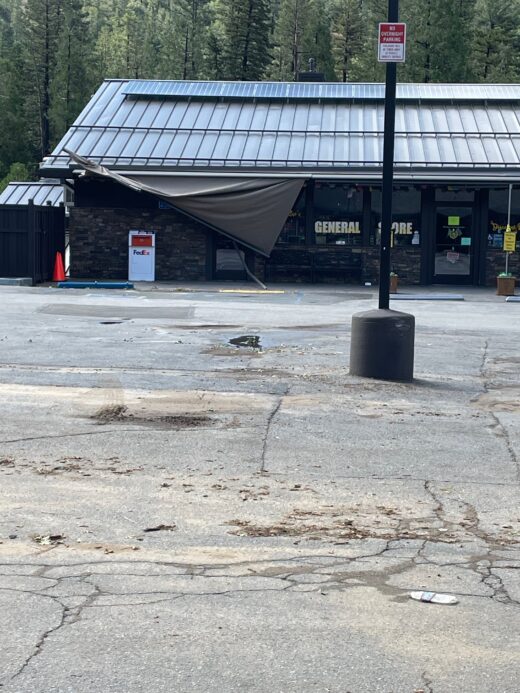Last week, President Joe Biden declared that a major disaster exists in parts of California affected by Tropical Storm Hilary that passed over the Hill during the middle of August. In Riverside County, the storm caused major flooding, mudflows, road closures and damage to critical infrastructures.
The declaration also ordered federal aid to supplement state, tribal and local recovery efforts in these areas.

PHOTOS BY JOEL FEINGOLD
While federal funding is available to state, tribal, eligible local governments and certain private nonprofit organizations for repairing or replacing facilities damaged by Hilary, Shane Reichart, senior public information specialist and public information officer for the county’s Emergency Management Department, lamented, “He did not approve ‘Individual assistance.’”

The Federal Emergency Management Agency money will cover the county’s expenses on a 75% cost-sharing basis. Federal funding also is available for hazard mitigation measures statewide. State assistance should cover 75% of the costs not covered by the federal funding, according to Reichardt.

“That’s a huge benefit for the county and cities,” he stated. “It provides significant relief.” In Riverside County, the cities of Calimesa, La Quinta, Palm Desert, Indio, Indian Wells and Desert Hot Springs, as well as the Morongo Band of Mission Indians, submitted local proclamations of emergency.

Hilary brought prolific rainfall. Amounts recorded on the Hill included 11.7 inches on Mount San Jacinto Peak, 7.8 inches at Snow Creek, and Pine Cove and Alandale (Stone Creek) received about 3.3 inches, while Keenwild and Vista Grande were in the 2.5-inch range.
For homeowners and businesses, the Small Business Administration (SBA) has other forms of funding. On Sept. 20, SBA Administrator Isabel Casillas Guzman said in a press release, “SBA’s mission-driven team stands ready to help California’s small businesses and residents impacted by tropical storm Hilary.”
“Low-interest federal disaster loans are available to businesses of all sizes, most private nonprofit organizations, homeowners and renters whose property was damaged or destroyed by this disaster,” added Director Jeffrey Lusk of the U.S. SBA’s Disaster Field Operations Center-West.
Businesses of all sizes and private nonprofit organizations may borrow up to $2 million to repair or replace damaged or destroyed real estate, machinery and equipment, inventory and other business assets. SBA also offers Economic Injury Disaster Loans to help meet working capital needs caused by the disaster. Economic injury assistance is available regardless of whether the business suffered any property damage.
SBA also can lend more funds to businesses and homeowners to help with the cost of improvements to protect, prevent or minimize the same type of disaster damage from occurring in the future. Disaster loans up to $500,000 are available to homeowners to repair or replace damaged or destroyed real estate. Homeowners and renters are eligible for up to $100,000 to repair or replace damaged or destroyed personal property, including personal vehicles.
Interest rates can be as low as 4% for businesses, 2.375% for private nonprofit organizations and 2.5% for homeowners and renters with terms up to 30 years. Loan amounts and terms are set by SBA and are based on each applicant’s financial condition, according to the SBA press release.
Interest does not begin to accrue until 12 months from the date of the first disaster loan disbursement. SBA disaster loan repayment begins 12 months from the date of the first disbursement.
Applicants may apply online, receive more disaster assistance information and download applications at https://disasterloanassistance.sba.gov/. Applicants may also call SBA’s Customer Service Center at 800-659-2955 or send an email to disastercustomerservice@sba.gov for more information on SBA disaster assistance.
4th District Supervisor V. Manuel Perez, in coordination with the Riverside County Executive Office and Emergency Management Department, said in a news release, “This is huge, and it is a very good thing!
“Hurricane Hilary touched just about every city and unincorporated community in the Coachella Valley. It’s the most costly natural disaster in county history, and most of the damage was in the Coachella Valley. The hurricane was unique and never happened before in our lifetime.
“Riverside County coordinated and mobilized before the storm hit us, and had many successes in getting our community members prepared, sending a wireless alert to all residents for the first time in our history, and keeping people out of danger. Our county and our cities have done a tremendous amount of work in response to the storm, and the work of transportation departments was exceptional in getting roads back up. But recovery is the longest period of a disaster, and there are many costs that have been incurred as we restore impacted infrastructure.
“The declaration will provide reimbursement to the county and cities for the repairs needed to public property, including county buildings, city facilities and public streets.
“We are very happy to get this news that President Biden granted a Presidential Major Disaster Declaration for Hurricane Hilary yesterday. On behalf of the County of Riverside, I would like to acknowledge and thank President Biden, Governor Newsom, California’s entire federal delegation, our state legislative representatives, my colleagues in local government, and many others for their support of the Coachella Valley’s recovery efforts.”
Riverside County will be coordinating with the California Office of Emergency Services to schedule a briefing for operational area partners (Riverside County cities, tribal nations and special districts) where more guidance for the federal public assistance process and cost eligibility will be given.






